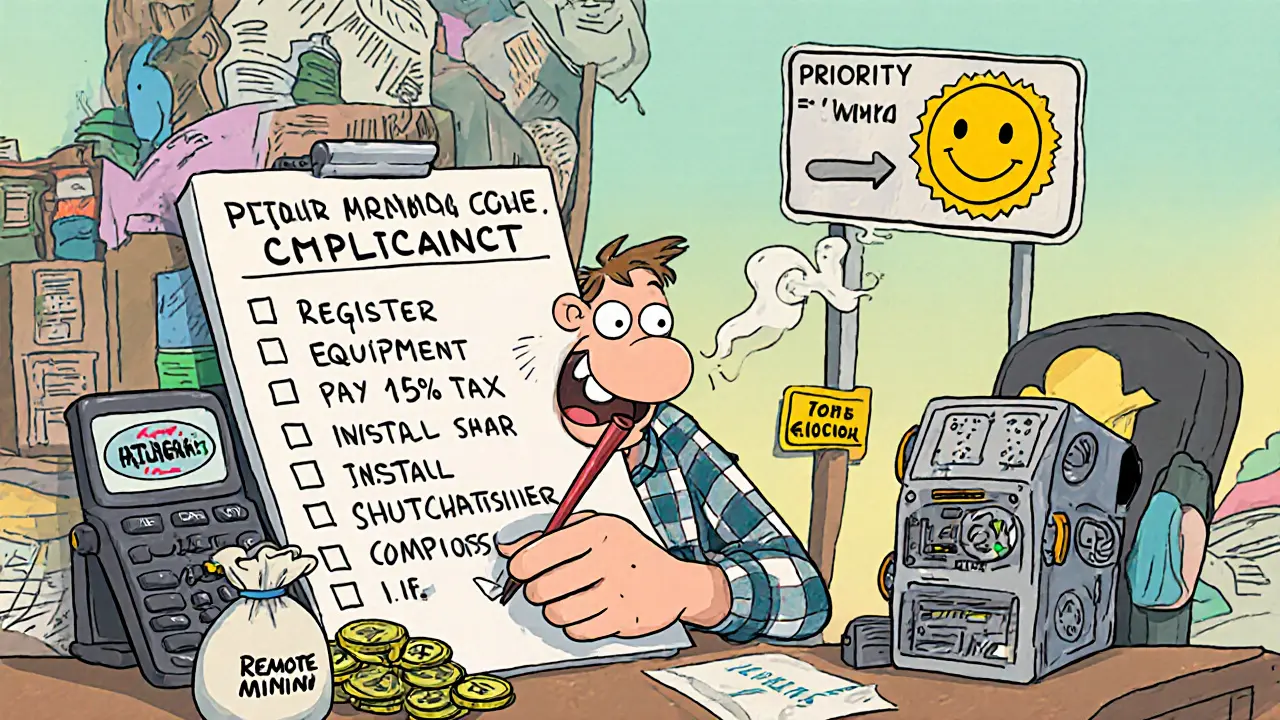Crypto Mining in Russia: Current Law, Regional Bans & Compliance Basics
 Oct, 9 2025
Oct, 9 2025
When it comes to crypto mining in Russia is a legal activity that falls under a specific set of regulations introduced in 2024 and enforced from 2025, understanding the law is crucial for anyone wanting to run a profitable operation or simply stay on the right side of the authorities.
Key Takeaways
- Russia moved from a blanket ban to a controlled legalization regime in late 2024.
- Ten regions have a total ban until 2031; three Siberian regions face seasonal shutdowns each winter.
- All miners using more than 6,000kWh per month must register in the state‑run miners' registry.
- Bitcoin mining profits are taxed at 15% as of November2024.
- Authorities can remotely disconnect equipment during peak‑demand periods; non‑compliant operators risk fines up to 2millionRUB.
Legal Framework Overview
The Russian government approved three key pieces of legislation in August and October2024. These laws define who may mine, how mining equipment must be labeled, and what tax obligations apply. The core objectives are to capture economic value, protect the national power grid, and keep digital‑currency activity under state oversight.
Under the new code, crypto mining businesses are classified as “fourth‑category” electricity consumers. That places them behind households, hospitals, and essential industries when the grid experiences stress. The law also mandates a mandatory state registry for all imported mining hardware, allowing regulators to identify and remotely shut down machines that threaten grid stability.
Regional Bans & Seasonal Limits
Geography plays a huge role in whether you can operate. The authorities introduced a two‑tier restriction system that will stay in place at least until March2031.
| Region | Type of Restriction | Effective Period |
|---|---|---|
| Dagestan | Full ban | 01‑01‑2025-15‑03‑2031 |
| Ingushetia | Full ban | 01‑01‑2025-15‑03‑2031 |
| Kabardino‑Balkaria | Full ban | 01‑01‑2025-15‑03‑2031 |
| Karachay‑Cherkessia | Full ban | 01‑01‑2025-15‑03‑2031 |
| North Ossetia‑Alania | Full ban | 01‑01‑2025-15‑03‑2031 |
| Chechnya | Full ban | 01‑01‑2025-15‑03‑2031 |
| Donetsk People’s Republic | Full ban | 01‑01‑2025-15‑03‑2031 |
| Lugansk People’s Republic | Full ban | 01‑01‑2025-15‑03‑2031 |
| Zaporizhzhia (occupied) | Full ban | 01‑01‑2025-15‑03‑2031 |
| Kherson (occupied) | Full ban | 01‑01‑2025-15‑03‑2031 |
| Irkutsk (Siberia) | Seasonal ban | 15‑11‑2025-15‑03‑2031 (each winter) |
| Buryatia (Siberia) | Seasonal ban | 15‑11‑2025-15‑03‑2031 (each winter) |
| Zabaikalsky Krai (Siberia) | Seasonal ban | 15‑11‑2025-15‑03‑2031 (each winter) |
These bans target areas where the power grid is already strained. If you plan to set up a farm in a permitted region, double‑check the local energy provider’s classification; some utilities voluntarily impose tighter limits.

Registration, Taxation & Reporting
Compliance starts with the miners' registry. Any operation consuming more than 6,000kWh per month must submit a registration form to the Federal Tax Service. The form requires:
- Detailed equipment list (serial numbers, power ratings)
- Estimated monthly electricity consumption
- Bank account for tax remittance
Profit generated from Bitcoin mining is subject to a flat 15% tax, introduced in November2024. The tax is calculated on the ruble‑converted value of mined coins at the day of receipt. Companies must file quarterly tax declarations; individuals with smaller operations file an annual return.
Transactions exceeding 600,000RUB must be reported to the tax authorities, echoing the broader Russian stance that crypto can be owned and traded but not used as legal tender.
Penalties & Enforcement Mechanisms
Enforcement has become more aggressive. The law gives authorities the right to:
- Remote‑shut down mining rigs during grid emergencies.
- Seize equipment that is not listed in the registry.
- Impose fines up to 2millionRUB for repeat offenders.
Violations also trigger possible criminal charges if the activity is deemed to endanger national security. According to Deputy Minister Ivan Chebeskov, only about 30% of miners were registered as of mid‑2025, so the enforcement wave is expected to intensify over the next two years.
Operational Considerations: Energy Priority & Remote Shutdown
The power grid’s priority ladder places mining at the bottom. If the grid’s load‑shedding algorithm detects a risk, a command is sent to the registered equipment’s smart controller, instantly cutting power. To mitigate unexpected downtime, many operators install backup generators or negotiate “priority slots” with local utilities, but those arrangements are rarely granted outside of specially designated industrial zones.
Choosing a jurisdiction with abundant renewable energy (e.g., the Khabarovsk region’s hydro surplus) can reduce the likelihood of shutdowns and lower electricity costs. However, keep in mind that the same renewable‑rich areas often fall under the seasonal ban list.

Compliance Checklist for New Miners
- Confirm regional eligibility: Verify that your chosen location is not on the full‑ban list and that seasonal windows align with your planned operation.
- Calculate expected consumption: If you’ll exceed 6,000kWh/month, prepare to register.
- Register equipment: Submit serial numbers, power specs, and ownership details to the miners' registry before purchasing hardware.
- Set up tax reporting: Open a dedicated bank account, convert mined coins to RUB at the receipt date, and apply the 15% tax rate.
- Implement remote‑shutdown compliance: Install the government‑approved controller firmware that accepts shutdown commands.
- Monitor energy usage: Use real‑time meters to stay under the 6,000kWh threshold if you wish to avoid registration.
- Keep documentation: Retain invoices, registration confirmations, and tax filings for at least five years.
Future Outlook (2025‑2031)
The Russian approach is a balancing act: encouraging investment while safeguarding the power grid. Expect the following trends:
- Potential increase of fines from 200,000RUB to the maximum 2millionRUB for repeat violations.
- Gradual expansion of “priority mining zones” in regions where new power plants are commissioned.
- Possible revision of the 15% tax if mining profitability spikes dramatically.
- Long‑term review of the six‑year regional bans; some areas may see relaxation if grid capacity improves.
For investors, the consensus among Russian analysts is to allocate no more than 5% of a diversified portfolio to mining ventures due to regulatory uncertainty and energy‑price volatility.
Frequently Asked Questions
Do I need a licence to mine Bitcoin in Russia?
No separate licence is required, but you must register your equipment with the state miners' registry if you consume more than 6,000kWh per month and pay the 15% profit tax.
Can I operate a mining farm in a region with a seasonal ban?
Only during the allowed months. For example, in Irkutsk you may run a farm from 15November to 15March; outside that window the equipment must be shut down or you risk hefty fines.
What happens if the grid shuts down my rigs?
The government‑approved controller will cut power automatically. Your hardware is safe, but you lose mining time and may incur a penalty if the shutdown occurs because you failed to register.
How is the 15% tax calculated?
Take the ruble value of the mined coins on the day you receive them, then apply a flat 15% rate. The amount is reported quarterly by businesses and annually by private miners.
Are there any tax deductions for electricity costs?
Yes. Electricity expenses can be deducted as operational costs when calculating taxable profit, provided you have proper invoices and the consumption is registered.
Orlando Lucas
October 9, 2025 AT 02:01Thinking about the Russian mining landscape, one sees a classic tension between innovation and regulation. The new framework tries to channel the energy surge into fiscal revenue while keeping the grid stable, which is a delicate balancing act. If miners treat compliance as a strategic partner rather than a hurdle, the sector could actually boost regional development. Moreover, the seasonal bans in Siberia hint at a pragmatic approach-shut down when the lights are needed elsewhere, resume when surplus reigns. In the long run, this could foster a more resilient ecosystem for both crypto and traditional utilities.
Rama Julianto
October 16, 2025 AT 00:18What a circus! Russia wants to “legalize” mining while they keep threatening you with remote shutdowns-yeah right. Those fines up to 2millionRUB are a joke unless they actually enforce them, which they clearly don’t. And don’t get me started on the half‑baked registration process-just another way for the state to keep tabs on you. If you thought this was a friendly invitation, think again.
Helen Fitzgerald
October 22, 2025 AT 22:35Hey, I get the frustration, but there are actually some practical steps you can take. Registering your gear early can smooth out the later headaches, and aligning with local utilities often gives you a little wiggle room. Also, many miners have found success by diversifying power sources, like pairing solar with the grid. So while the vibe feels hostile, a bit of proactive planning can turn that around.
Jon Asher
October 29, 2025 AT 20:51Russia’s new rules basically put miners at the back of the line for electricity. If the grid gets stressed, your rigs get the boot first. It’s a clear signal: energy priority overrides crypto priorities.
Scott Hall
November 5, 2025 AT 19:08Exactly, and that’s why many operators are adding backup generators. It’s not ideal, but having a fallback can keep you mining during those forced outages. Plus, some regions are more lenient, so scouting locations early pays off.
Nina Hall
November 12, 2025 AT 17:25Whoa, the tax vibe is wild! A flat 15% on mining profit might sound tame, but when you factor in the electricity costs and those hefty fines, it’s a roller‑coaster. Still, the idea of “priority mining zones” sounds like a neon sign saying “Earn while you wait”. If you can land a spot in a hydro‑rich area, you might just turn the whole regulatory maze into a gold mine.
Lena Vega
November 19, 2025 AT 15:41Good point.
Mureil Stueber
November 26, 2025 AT 13:58The registry requirement is a real checkpoint it forces operators to be transparent and it also gives authorities a lever to manage load It’s not just paperwork it’s a safety net for the grid